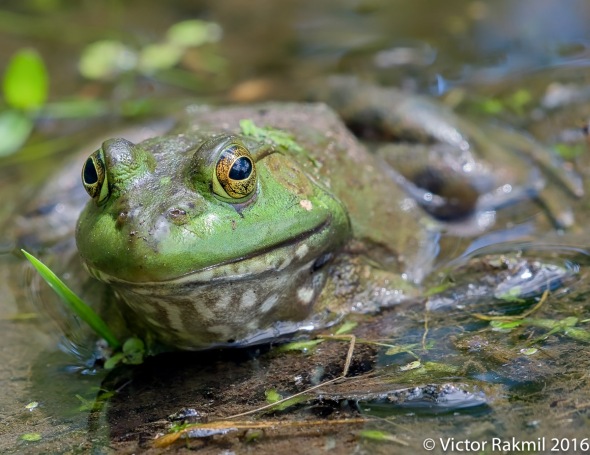A Comma Butterfly, a Frog and more on Sharp Photographs
 To view more of my photography please click on www.rakmilphotography.com
To view more of my photography please click on www.rakmilphotography.com
One thing that comes closest to a rule in photography is that eyes should be sharp. It is possible you can just make me out in the reflection in the frog’s eye.
Part VI: Sharp Photos and Post-Processing
When we bring our photo into our processor, chances are a bit more sharpening will be added by the software to ensure the photo meets the requirements of the program and the monitor and not look artificially soft. When I edit my photos I spend time on exposure and other global adjustments but I need to pay particular attention to the shadows. Opening them up, lightening the file can cause noise and some softness. Several things can happen in camera that can impact a photo’s sharpness. If we had to use a high ISO we may have generated some noise. Noise can defeat sharpness and noise removal can soften a picture. I always remove noise before sharpening (though this is not the recommended order for some photographers, I just do not like sharpening noise.). Sometimes the noise removal removes too much detail and when making choices I will err on the side of noise to get a sharper photo. Once the noise is removed I have several different ways I can go about sharpening. I use Photoshop’s Smart Sharpen for global sharpening, this is where I am most likely to see a halo and need to paint it away. Many people only selectively sharpen their photos, but I do one global adjustment before looking at tonal contrast, detail enhancement software that takes sharpness to another level. Nik has detail extractor, which permits very selective detail enhancement/sharpening and MacPhun Intensity CK has some good algorithms for detail enhancement. In both these products, traditional sharpening of the nexus between pixels is replaced by the sharpening of the contrasts between tones. Topaz Labs and various techniques in Photoshop can give you other methods of sharpening, detail, clarity or tonal contrast. All the programs I have mentioned used in moderation can make a photo sharper, used to their limits a photo can get “crunchy”. Very slight adjustments go a long way in telling the brain about detail. All of the programs I have mentioned have excellent video training on line for free.


Great photos
LikeLike
July 20, 2016 at 12:00 pm
Thank you
LikeLike
July 20, 2016 at 1:13 pm
Love that frog!
LikeLiked by 1 person
July 18, 2016 at 5:06 am
Excellent image. Point on focus.
LikeLike
July 17, 2016 at 4:15 pm
Thank you
LikeLike
July 17, 2016 at 4:19 pm
You’re welcome.
LikeLiked by 1 person
July 17, 2016 at 4:43 pm
Beautiful detail in both images!
LikeLike
July 17, 2016 at 3:20 pm
Thank you
LikeLike
July 17, 2016 at 3:55 pm
Good information Victor. I am also a big fan of Detail Extractor and Tonal Contrast. I usually apply sharpening after noise reduction (when needed), but I am in Photoshop by that point so that I can apply sharpening to only my subject using a brush, and can control the intensity using the opacity slider.
LikeLike
July 17, 2016 at 12:33 pm
Excellent points. Thanks
LikeLike
July 17, 2016 at 12:53 pm
Beautiful photos Victor. The colours and detail are wonderful. Interesting reading about your sharpening techniques. Depending on the subject, I always sharpen first. I used to use unsharp mask, but tend to use smart sharpen, and I also like the high pass technique. What noise removal technique do you use? I have used reduce noise, but you do have to be wary about loosing detail. I also use the blur tool to selectively remove noise from large areas.
LikeLike
July 17, 2016 at 9:59 am
I don’t like sharpening noise, hence my choice. For noise reduction I use Noiseless CK from MacPhun for Mac only. It’s a miracle program.
LikeLiked by 1 person
July 17, 2016 at 10:04 am
Indeed, your excellent photographs express this.
LikeLiked by 1 person
July 17, 2016 at 10:16 am
Such great detail. I love seeing things I wouldn’t normally notice, like the mottling on the frog’s throat and the comma’s green, wooly thorax. Wonderful captures!
LikeLiked by 1 person
July 17, 2016 at 9:16 am
Thank you. Loads of fun shooting these.
LikeLike
July 17, 2016 at 9:17 am
stunning handsome angel
LikeLike
July 17, 2016 at 7:04 am
Thank you
LikeLike
July 17, 2016 at 7:11 am